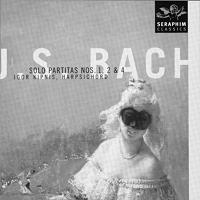|
<< -- 2 -- David Ponsford Issued afresh

At the time of this recording, Igor Kipnis was among the first generation
of harpsichordists to use copies of historical instruments, along with Kenneth
Gilbert and Gustav Leonhardt. He recorded the Partitas in the late 1970s,
and it is these recordings which have now been digitally remastered and
issued afresh. Kipnis's harpsichord was made by Rutkowski and Robinette
(New York, 1970) and is a copy of a very large instrument by Hass replete
with a 16' set of strings which Kipnis uses in the opening movements of
Nos 2, 4 and 6. The sheer variety of registration colours is a feature of
this recording, and this perhaps marks it as stemming from the early days
of authentically-inspired performance practice. The recording sounds very
close but has added (electronic) resonance as well, making for a rather
unreal sound -- a harpsichord in full technicolor, if you like.

Whilst there is no doubt that this is committed playing, Kipnis has a
few conceptual habits with which I cannot agree. The most obvious concerns
repeats of dance movements. Kipnis often markedly simplifies Bach's text
during the first playing, and then plays the repeat according to the printed
page. What to do with repeats is, of course, a relevant issue, but this
is a most unusual interpretation. A more logical solution would be to start
with the printed text and then perhaps extend the degree of ornamentation.
Kipnis seems unwilling to let the music itself speak, and a certain over-fussiness
pervades the recording. Sometimes, as in the case of some Allemandes, this
act of simplification leads to a faster tempo, and the same principle leads
to a regrettable change from sarabande tendre to sarabande grave
in Partita No 2. Elsewhere, Kipnis hardly allows the music to settle -- long
notes at ends of sections are inevitably truncated.
The recording, at modern pitch, is not entirely clean, and my attention
was drawn to various electronic and some natural noises (including crickets
in the background), but this recording has a certain historical importance,
being made by a great player at the beginning of a newly-found interest
in Bach on period instruments. At that time, advocacy of the harpsichord
for Bach performances must have been a prime concern. Perhaps Kipnis erred
on the side of adventurousness in registration to contrast with all the
American piano performances at that time. Nowadays, we have no need of such
evangelism for the harpsichord, and we can let the music freely speak for
itself.
Copyright © 16 September 2001
David Ponsford, Gloucestershire, UK
 CD INFORMATION - EMI CLASSICS (USA) 5 73700 2
PURCHASE TOCCATAS 1,2&4 FROM AMAZON
CD INFORMATION - ANGEL RECORDS 5 74007 2
PURCHASE TOCCATAS 3,5&6 FROM AMAZON
<< Music
& Vision home Recent reviews
Placido Domingo >>
CD INFORMATION - EMI CLASSICS (USA) 5 73700 2
PURCHASE TOCCATAS 1,2&4 FROM AMAZON
CD INFORMATION - ANGEL RECORDS 5 74007 2
PURCHASE TOCCATAS 3,5&6 FROM AMAZON
<< Music
& Vision home Recent reviews
Placido Domingo >>
|

